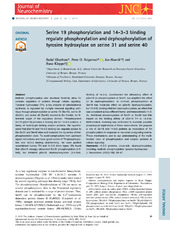| dc.contributor.author | Ghorbani, Sadaf | en_US |
| dc.contributor.author | Szigetvari, Peter Daniel | en_US |
| dc.contributor.author | Haavik, Jan | en_US |
| dc.contributor.author | Kleppe, Rune | en_US |
| dc.date.accessioned | 2020-06-18T17:43:04Z | |
| dc.date.available | 2020-06-18T17:43:04Z | |
| dc.date.issued | 2019-09-17 | |
| dc.Published | Ghorbani S, Szigetvari, Haavik, Kleppe. Serine 19 phosphorylation and 14‐3‐3 binding regulate phosphorylation and dephosphorylation of tyrosine hydroxylase on serine 31 and serine 40. Journal of Neurochemistry. 2020;152:29-47 | eng |
| dc.identifier.issn | 1471-4159 | |
| dc.identifier.issn | 0022-3042 | |
| dc.identifier.uri | https://hdl.handle.net/1956/22722 | |
| dc.description.abstract | Multisite phosphorylation and structural flexibility allow for complex regulation of proteins through cellular signaling. Tyrosine hydroxylase (TH), a key enzyme of catecholamine synthesis, is regulated by multiple neuronal signaling pathways through phosphorylation at serine 19 (Ser19), serine 31 (Ser31), and serine 40 (Ser40) located in the flexible, far N‐terminal region of the regulatory domain. Phosphorylated Ser19 (pSer19) provides a binding site for 14‐3‐3 proteins, a family of multi‐target binding adaptor proteins. We hypothesized that pSer19 and 14‐3‐3 binding can regulate access to the Ser31 and Ser40 sites and modulate the dynamics of their phosphorylation state. To avoid complications from upstream signal interactions and have good control of TH‐phosphorylation and 14‐3‐3 binding stoichiometry, we used purified recombinant human TH and 14‐3‐3 dimer types. We found that pSer19 strongly stimulated Ser31 phosphorylation (4.6‐fold), but inhibited pSer31 dephosphorylation (3.4‐fold). Binding of 14‐3‐3ζ counteracted the stimulatory effect of pSer19 on phosphorylation at Ser31, but amplified the effect on its dephosphorylation. In contrast, phosphorylation at Ser19 had moderate effect on pSer40 dephosphorylation, but 14‐3‐3ζ binding inhibited dephosphorylation, an effect that was consistent across different homo‐ and heterodimeric 14‐3‐3s. Additional phosphorylation of Ser31 or Ser40 had little impact on the binding affinity of pSer19 TH to 14‐3‐3s. Mathematical modeling was performed to elucidate possible physiological implications of these observations. We propose a role of Ser19 and 14‐3‐3 proteins as modulators of TH phosphorylation in response to neuronal co‐signaling events. These mechanisms add to our understanding of the multifaceted roles of phosphorylation and adaptor proteins in cellular signaling. | en_US |
| dc.language.iso | eng | eng |
| dc.publisher | Wiley | eng |
| dc.rights | Attribution CC BY | eng |
| dc.rights.uri | http://creativecommons.org/licenses/by/4.0/ | eng |
| dc.subject | 14-3-3 proteins | eng |
| dc.subject | cross-talk | eng |
| dc.subject | dephosphorylation | eng |
| dc.subject | modeling | eng |
| dc.subject | multisite phosphorylation | eng |
| dc.subject | tyrosine hydroxylase | eng |
| dc.title | Serine 19 phosphorylation and 14‐3‐3 binding regulate phosphorylation and dephosphorylation of tyrosine hydroxylase on serine 31 and serine 40 | en_US |
| dc.type | Peer reviewed | |
| dc.type | Journal article | |
| dc.date.updated | 2020-01-30T07:31:58Z | |
| dc.description.version | publishedVersion | en_US |
| dc.rights.holder | Copyright 2019 The Author(s) | |
| dc.identifier.doi | https://doi.org/10.1111/jnc.14872 | |
| dc.identifier.cristin | 1759272 | |
| dc.source.journal | Journal of Neurochemistry | |

